The Propranolol Drug Market is estimated to be valued at USD 1.3 billion in 2025 and is projected to reach USD 2.0 billion by 2035, registering a compound annual growth rate (CAGR) of 4.5% over the forecast period.
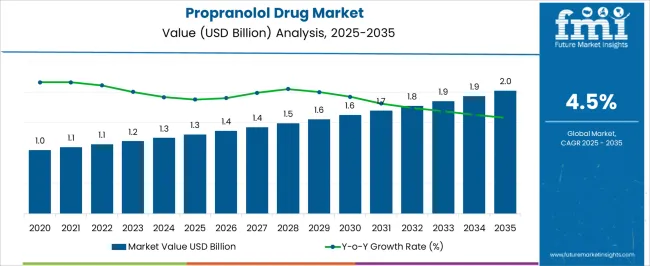
| Metric | Value |
|---|---|
| Propranolol Drug Market Estimated Value in (2025 E) | USD 1.3 billion |
| Propranolol Drug Market Forecast Value in (2035 F) | USD 2.0 billion |
| Forecast CAGR (2025 to 2035) | 4.5% |
The propranolol drug market is demonstrating consistent growth, supported by its widespread therapeutic applications across cardiovascular, neurological, and psychiatric conditions. Increasing prevalence of hypertension, arrhythmia, and anxiety-related disorders is contributing to higher prescription rates. The drug’s proven efficacy, long-established safety profile, and inclusion in multiple treatment guidelines are strengthening its position in both developed and emerging markets.
The availability of propranolol in multiple dosage forms and its cost-effectiveness compared to newer alternatives are supporting broad patient accessibility. Expanding healthcare infrastructure, rising awareness about cardiovascular health, and the growing burden of lifestyle-related diseases are further reinforcing demand. Patent expirations and the resulting proliferation of generics are improving affordability and boosting market penetration, particularly in low and middle-income economies.
In addition, ongoing research into off-label applications, including treatment of migraine and certain anxiety disorders, is expected to expand its clinical utility With increasing investments in chronic disease management and the rising global need for affordable therapeutics, the market outlook for propranolol remains highly favorable over the coming years.
The propranolol drug market is segmented by route of administration, disease indication, end user, and geographic regions. By route of administration, propranolol drug market is divided into Oral Administration, Solid, Liquid, and IV Administration. In terms of disease indication, propranolol drug market is classified into Hypertension, Angina, Migraine, and Tremors. Based on end user, propranolol drug market is segmented into Hospitals, Clinics, Home Care Settings, and Ambulatory Surgical Centers. Regionally, the propranolol drug industry is classified into North America, Latin America, Western Europe, Eastern Europe, Balkan & Baltic Countries, Russia & Belarus, Central Asia, East Asia, South Asia & Pacific, and the Middle East & Africa.
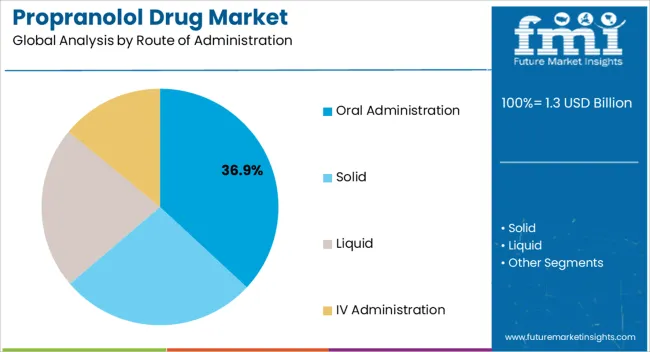
The oral administration segment is projected to account for 36.9% of the propranolol drug market revenue share in 2025, making it the leading route of administration. This preference is being reinforced by the convenience, non-invasiveness, and cost-effectiveness associated with oral dosage forms. Oral propranolol offers predictable pharmacokinetics and allows for standardized dosing schedules that enhance treatment adherence among patients.
The widespread availability of tablets and capsules through hospital pharmacies, retail outlets, and online channels further supports accessibility and consistent usage. Oral formulations also provide flexibility in dosing adjustments, which is particularly important in managing chronic conditions such as hypertension, arrhythmia, and migraine. The ease of large-scale manufacturing and distribution of oral drugs has contributed to their global dominance in cardiovascular therapy.
Patients and healthcare providers continue to prefer oral administration for its simplicity, reduced need for clinical supervision, and suitability for long-term therapy These combined factors reinforce the segment’s position as the most widely adopted route for propranolol delivery in global healthcare markets.
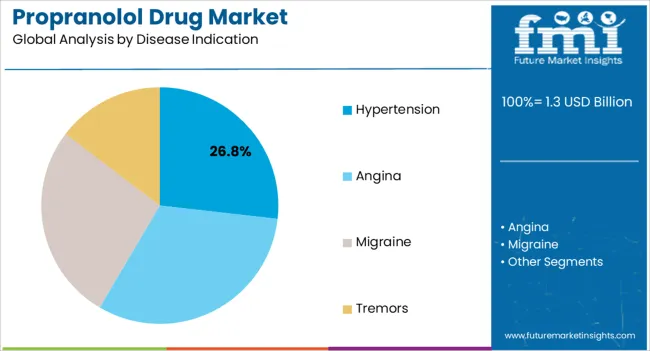
The hypertension indication segment is anticipated to represent 26.8% of the propranolol drug market revenue share in 2025, positioning it as the leading therapeutic application. This leadership is being driven by the rising global prevalence of hypertension, which is one of the most significant risk factors for cardiovascular morbidity and mortality. Propranolol’s ability to effectively reduce blood pressure by decreasing cardiac output and inhibiting sympathetic activity has made it an established component of antihypertensive regimens.
Its inclusion in international treatment guidelines and its affordability compared to newer drug classes have reinforced its consistent usage. The demand for cost-effective solutions to manage chronic cardiovascular diseases in both developed and developing economies is supporting further adoption. Additionally, increasing awareness of hypertension management and early diagnosis programs are driving higher treatment rates.
The drug’s proven long-term safety record and broad clinical acceptance have positioned it as a reliable therapeutic choice As hypertension rates continue to climb globally, the segment’s dominance is expected to remain strong in the years ahead.
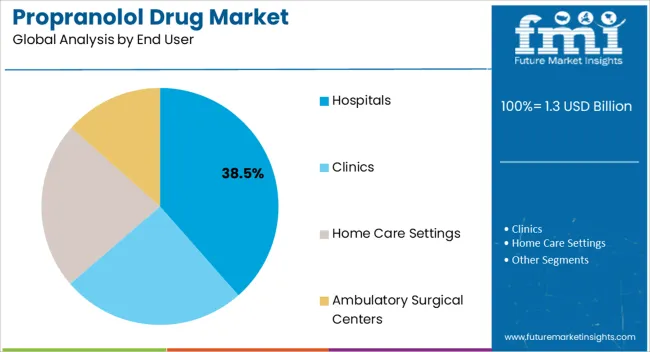
The hospitals segment is expected to capture 38.5% of the propranolol drug market revenue share in 2025, making it the leading end-use industry. This dominance is being reinforced by the critical role hospitals play in diagnosing and managing acute and chronic cardiovascular conditions where propranolol is commonly prescribed. Hospitals are the primary centers for initiating therapy in cases such as arrhythmia, hypertension, and post-myocardial infarction management, thereby ensuring high demand for the drug within these facilities.
The availability of specialized healthcare professionals and advanced diagnostic infrastructure supports accurate dosing and monitoring of propranolol therapy. Additionally, hospitals often act as the central distribution point for both inpatient care and outpatient prescriptions, further strengthening their share in the market.
Increasing hospital admissions due to lifestyle-related cardiovascular disorders, combined with the rising global burden of chronic diseases, is amplifying demand With growing healthcare infrastructure investments and an expanding patient base requiring continuous monitoring, hospitals are expected to remain the dominant end-user segment for propranolol therapies in the foreseeable future.
Propranolol is a beta adrenergic receptor-blocking type medication used in the treatment or prevention of high blood pressure, post-traumatic stress disorder, irregular heartbeats, tremors, angina pectoris, migraine and anxiety. According to study published in American Heart Association, Inc., hypertension is the leading risk factor for disability and death worldwide.
In 2010, Asia and Pacific region had highest burden of hypertension with 439 Mn people suffering from hypertension. As per WHO, propranolol is considered as one of the most essential pharmaceutical drug required in a basic health system. The drug is non selective beta blocker and also able to cross via blood –brain barrier. It inhibit the actions of neurotransmitter and enhances memory consolidation.
This advantage of propranolol made it useful for brain disorder too, which created a positive impact of propranolol drug in both heart and brain disorder. Propranolol drug is investigated as potential treatment for post-traumatic stress disorder. Propranolol was first marketed in 1965 under the brand name Inderal by ICI Pharmaceutical which is now known as AstraZeneca.
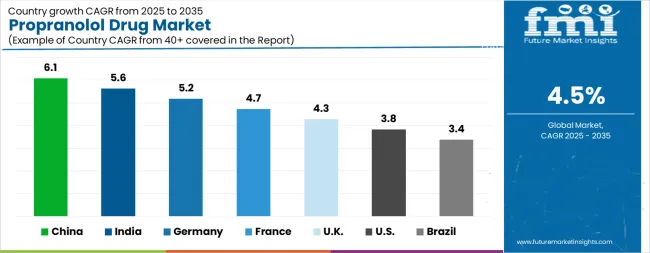
| Country | CAGR |
|---|---|
| China | 6.1% |
| India | 5.6% |
| Germany | 5.2% |
| France | 4.7% |
| UK | 4.3% |
| USA | 3.8% |
| Brazil | 3.4% |
The Propranolol Drug Market is expected to register a CAGR of 4.5% during the forecast period, exhibiting varied country level momentum. China leads with the highest CAGR of 6.1%, followed by India at 5.6%. Developed markets such as Germany, France, and the UK. continue to expand steadily, while the USA is likely to grow at consistent rates. Brazil posts the lowest CAGR at 3.4%, yet still underscores a broadly positive trajectory for the global Propranolol Drug Market. In 2024, Germany held a dominant revenue in the Western Europe market and is expected to grow with a CAGR of 5.2%. The USA Propranolol Drug Market is estimated to be valued at USD 445.3 million in 2025 and is anticipated to reach a valuation of USD 648.1 million by 2035. Sales are projected to rise at a CAGR of 3.8% over the forecast period between 2025 and 2035. While Japan and South Korea markets are estimated to be valued at USD 70.9 million and USD 44.0 million respectively in 2025.
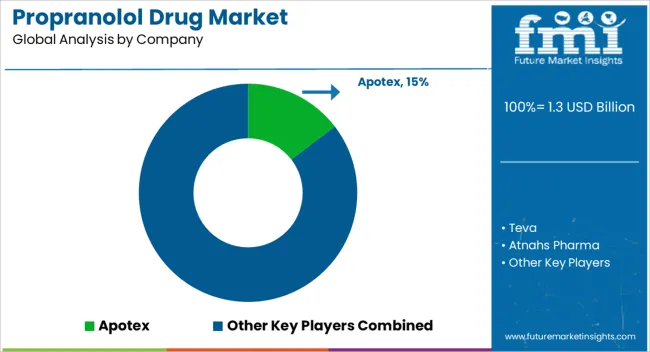
| Item | Value |
|---|---|
| Quantitative Units | USD 1.3 Billion |
| Route of Administration | Oral Administration, Solid, Liquid, and IV Administration |
| Disease Indication | Hypertension, Angina, Migraine, and Tremors |
| End User | Hospitals, Clinics, Home Care Settings, and Ambulatory Surgical Centers |
| Regions Covered | North America, Europe, Asia-Pacific, Latin America, Middle East & Africa |
| Country Covered | United States, Canada, Germany, France, United Kingdom, China, Japan, India, Brazil, South Africa |
| Key Companies Profiled | Apotex, Teva, Atnahs Pharma, AstraZeneca, Mylan, Novartis, Sanofi, Yabang Pharma, Sawai Seiyaku, ABZ-Pharma, Towa Yakuhin, and Zydus Pharma |
The global propranolol drug market is estimated to be valued at USD 1.3 billion in 2025.
The market size for the propranolol drug market is projected to reach USD 2.0 billion by 2035.
The propranolol drug market is expected to grow at a 4.5% CAGR between 2025 and 2035.
The key product types in propranolol drug market are oral administration, solid, liquid and iv administration.
In terms of disease indication, hypertension segment to command 26.8% share in the propranolol drug market in 2025.






Our Research Products

The "Full Research Suite" delivers actionable market intel, deep dives on markets or technologies, so clients act faster, cut risk, and unlock growth.

The Leaderboard benchmarks and ranks top vendors, classifying them as Established Leaders, Leading Challengers, or Disruptors & Challengers.

Locates where complements amplify value and substitutes erode it, forecasting net impact by horizon

We deliver granular, decision-grade intel: market sizing, 5-year forecasts, pricing, adoption, usage, revenue, and operational KPIs—plus competitor tracking, regulation, and value chains—across 60 countries broadly.

Spot the shifts before they hit your P&L. We track inflection points, adoption curves, pricing moves, and ecosystem plays to show where demand is heading, why it is changing, and what to do next across high-growth markets and disruptive tech

Real-time reads of user behavior. We track shifting priorities, perceptions of today’s and next-gen services, and provider experience, then pace how fast tech moves from trial to adoption, blending buyer, consumer, and channel inputs with social signals (#WhySwitch, #UX).

Partner with our analyst team to build a custom report designed around your business priorities. From analysing market trends to assessing competitors or crafting bespoke datasets, we tailor insights to your needs.
Supplier Intelligence
Discovery & Profiling
Capacity & Footprint
Performance & Risk
Compliance & Governance
Commercial Readiness
Who Supplies Whom
Scorecards & Shortlists
Playbooks & Docs
Category Intelligence
Definition & Scope
Demand & Use Cases
Cost Drivers
Market Structure
Supply Chain Map
Trade & Policy
Operating Norms
Deliverables
Buyer Intelligence
Account Basics
Spend & Scope
Procurement Model
Vendor Requirements
Terms & Policies
Entry Strategy
Pain Points & Triggers
Outputs
Pricing Analysis
Benchmarks
Trends
Should-Cost
Indexation
Landed Cost
Commercial Terms
Deliverables
Brand Analysis
Positioning & Value Prop
Share & Presence
Customer Evidence
Go-to-Market
Digital & Reputation
Compliance & Trust
KPIs & Gaps
Outputs
Full Research Suite comprises of:
Market outlook & trends analysis
Interviews & case studies
Strategic recommendations
Vendor profiles & capabilities analysis
5-year forecasts
8 regions and 60+ country-level data splits
Market segment data splits
12 months of continuous data updates
DELIVERED AS:
PDF EXCEL ONLINE
Drug Taste Masking Technologies Market Forecast and Outlook 2025 to 2035
Drug-Gene Interaction Panels Market Size and Share Forecast Outlook 2025 to 2035
Drug Testing Systems Market Size and Share Forecast Outlook 2025 to 2035
Drug Tester Market Size and Share Forecast Outlook 2025 to 2035
Drug Device Combination Products Market Size and Share Forecast Outlook 2025 to 2035
Drug Discovery Enzymes Market Size and Share Forecast Outlook 2025 to 2035
Drug Integrated Polymer Fibers Market Size and Share Forecast Outlook 2025 to 2035
Drug Discovery Outsourcing Market Size and Share Forecast Outlook 2025 to 2035
Drug Formulation Market Analysis - Size, Growth, & Forecast Outlook 2025 to 2035
Drug-Induced Dyskinesia Market Size and Share Forecast Outlook 2025 to 2035
Drug Free Depression Treatment Market Size and Share Forecast Outlook 2025 to 2035
Drug Delivery Technology Market is segmented by route of administration, and end user from 2025 to 2035
Drugs Glass Packaging Market Analysis - Size, Share, and Forecast Outlook 2025 to 2035
Drug Delivery Solutions Market Insights - Growth & Forecast 2025 to 2035
Drug Designing Tools Market Growth – Trends & Forecast 2025 to 2035
Drug of Abuse Testing Market Growth – Trends & Forecast 2025-2035
Drug-Induced Immune Hemolytic Anemia Market - Demand & Forecast 2025 to 2035
Drug Discovery Services Market Insights - Trends & Growth 2025 to 2035
Drug Screening Market Overview - Trends, Demand & Forecast 2025 to 2035
Drug Eruptions Treatment Market - Innovations & Future Outlook 2025 to 2035

Thank you!
You will receive an email from our Business Development Manager. Please be sure to check your SPAM/JUNK folder too.
Chat With
MaRIA